6 Cold Hardy Fruit Trees for North Texas
Fruit trees are a great way to add food production to home landscapes AND some just happen to beautiful to boot! These 6 trees are some of our favorite easy to care for ornamental edibles that both look and taste great , PLUS the 6 trees listed below can reliably withstand our often harsh and unpredictable climate! February is a great time to plant fruit trees in North Texas, so pick your favorites and make a plan for planting!
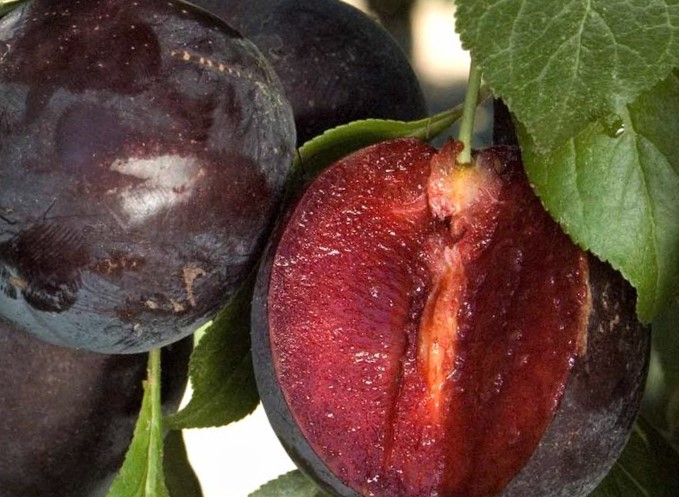
(Prunus salicina ‘Burgundy’)
Description:
One of the best-tasting plums that will thrive in North Texas! The picture perfect 11/2” wide fruits have maroon colored skin and firm, semi-freestone flesh that is deep purple-red color. The flavors are extremely sweet with very little tartness and a delightful wine-like aftertaste. Delectable fruits have a firm– but juicy texture for an exceptional summertime treat.
This highly ornamental tree is perfect for an urban edible landscape, with a medium sized upright form, incredibly gorgeous spring flowers and striking red fall foliage. And unlike other plum cultivars, you only need to plant one tree as they are self-fertile—not requiring a second pollinizer.
BONUS: ‘Burgundy‘ is very productive, often considered a super producer and because the fruits keep well on the tree, you can expect a prolonged harvest longer into the summer.
Uses: These are perfect for fresh eating when warmed by the summer sun but can also be cut in half and grilled for a healthy desert (or grilled and served over ice cream for a less healthy option). They are also perfect for smoothies, fruit salads, dried as a snack, baked in fresh bread or enjoyed throughout the year as preserves!
TREE SIZE: 2 year old tree that is 4-5 feet tall
ESTIMATED CHILLING REQUIREMENTS (BELOW 45 DEGREES): 300 chill hours
COLD HARDINESS: -15° to -20° F
POLLINATION: Self-fruitful
RIPENING DATE: June-July
ROOT STOCK: Myro 29C is well adapted to the challenging soils of North Texas.
SPACING: Plant trees 12-15 feet apart
FLAVOR OF FRUIT: Super sweet and mellow tartness
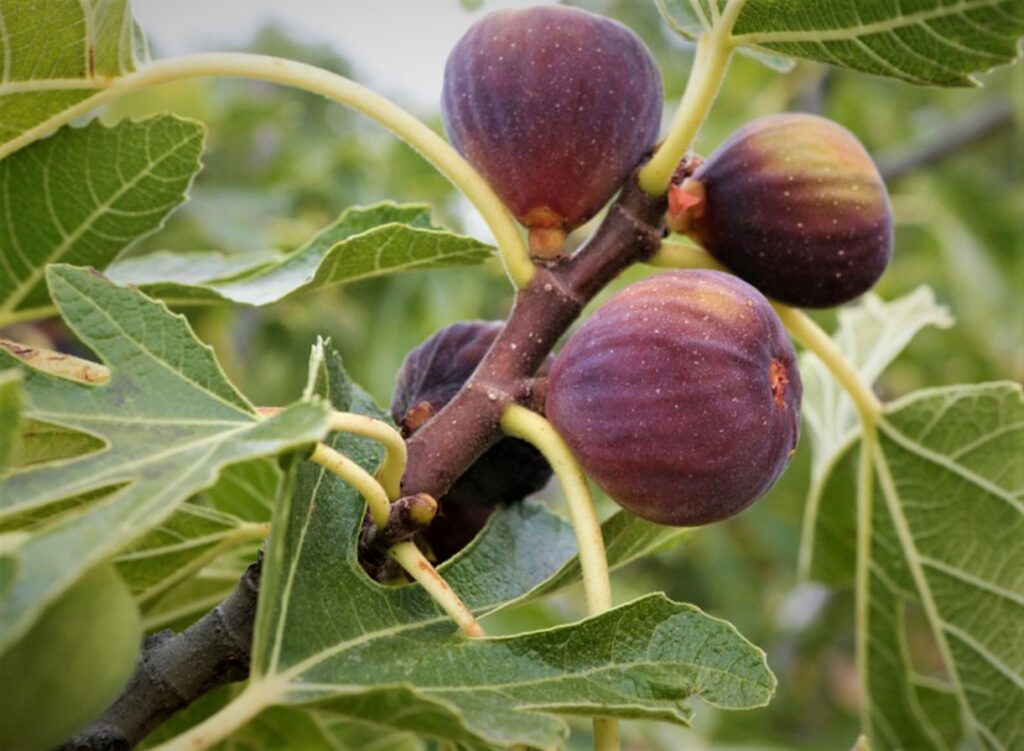
(Ficus carica ‘Violette de Bordeaux’)
Description:
This heirloom fig is widely considered to be one of the best tasting figs in the world–and also happens to be well-adapted to growing in the challenging climate and soils of North Texas! This ornamental and naturally- dwarfed, compact tree is well-suited for urban edible landscapes and produce pear-shaped, medium-sized rich royal purple fruit. The flesh inside is a very deep strawberry-red and has a distinctive, sweet, rich flavor often described as fruit-candy.
This fig does not require a second pollenizer to produce and will actually produce two crops in a year with “breba”fruit in late spring (which grows on older wood) serving as a prequel to the main crop which arises late summer into fall on new growth.
There are few fruits that rival the heavenly taste of a tree-ripened ‘Violette de Bordeaux’ fig. Unlike other fruits, figs do not after-ripen when picked, so store-bought figs picked too soon for shipping pale in comparison to growing your own tree.
Pro-tip: Pick figs when they soften to the texture of an overripe banana for best results. Best eaten fresh when picked, still warm from the summer sun. Spread ripe figs on buttered toast, grill and wrap with prosciutto ham, atop a salad or paired (fresh or dried) with your favorite cheese. Share with your friends and family or guiltily eat by yourself when hiding behind the tree. “What figs?” “The birds must have gotten to them.”
Bonus: The tropical looking deeply lobed foliage is also useful imparting a coconut-like flavor to grilled or roasted meat. Leaves can also be used to make a delicious heart-healthy coconut flavored tea.
Also perfect for growing in outdoor containers on your deck or balcony.
TREE SIZE: 2-years-old tree that is 3-4 feet tall
ESTIMATED CHILLING REQUIREMENTS (BELOW 45 DEGREES): 100 hours below 45°F
COLD HARDINESS: -10° F
POLLINATION: Self-fruitful. No pollinizer required
RIPENING DATE: June – October
SPACING: Plant trees 12-15 feet apart
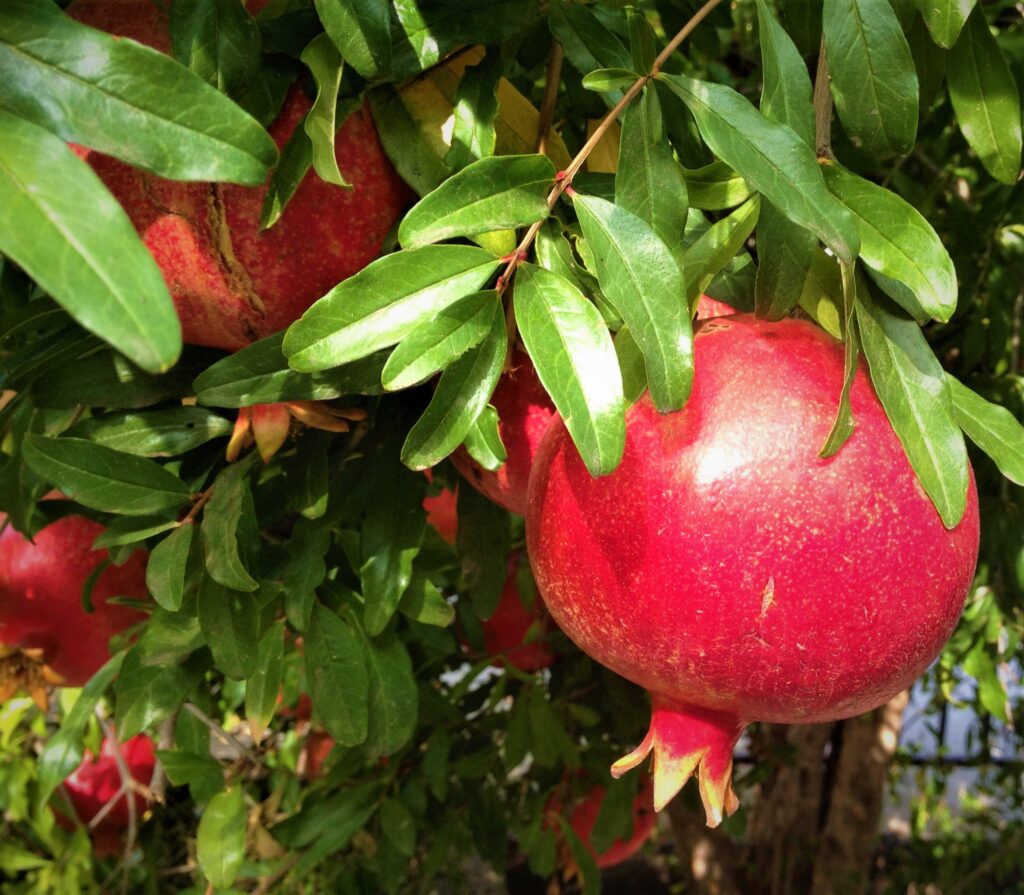
Punica granatum ‘Al Sirin Nar’’
Description:
The large and deeply colored beautiful bright glossy red fruits are prized as one of the best tasting pomegranate cultivars with a sweet, tart bal. Inside the supple crimson arils are sweet with a balance of tartness surrounding their small, soft, edible seed. This variety is dependable and very productive, producing plenty of fruit form a young age that are great for fresh eating or for juicing.
The highly ornamental, vigorous shrubs are cold hardy down to 5° F and are
perfect for an edible landscape. They can reach a mature height of 8’- 10’ — or can be maintained to a height of 4-5 feet by a yearly summer pruning.
Fruits are harvested September- October as they deepen in color, transition from round to slightly angular and become softer when squeezed. The delectable seeds make a perfect slightly crunchy addition the fall salads, are wonderful sprinkled on yogurt or oatmeal for breakfast, or make an incredibly beautiful and flavor packed garnish over a variety of grilled meat dishes.
Bonus: The beautiful rose-like red flowers of the pomegranate are a favorite of hummingbirds. They are also edible for humans, with the male flowers (which don’t produce fruit) historically used to make a refreshing floral tea.
TREE SIZE: 2 Year old tree
ESTIMATED CHILLING REQUIREMENTS (BELOW 45 DEGREES): 200 hours.
COLD HARDINESS: Needs protection near or below 5° F
POLLINATION: Self-Fruitful (No Pollinator Required)
RIPENING DATE: October
SPACING: Plant trees 6-10 feet apart
FLAVOR OF FRUIT: High juice quality with a sweet-tart taste. This large glossy red fruit produces a light pink aril and has been said to have the heaviest crop production among well producing pomegranate varieties in the USA.
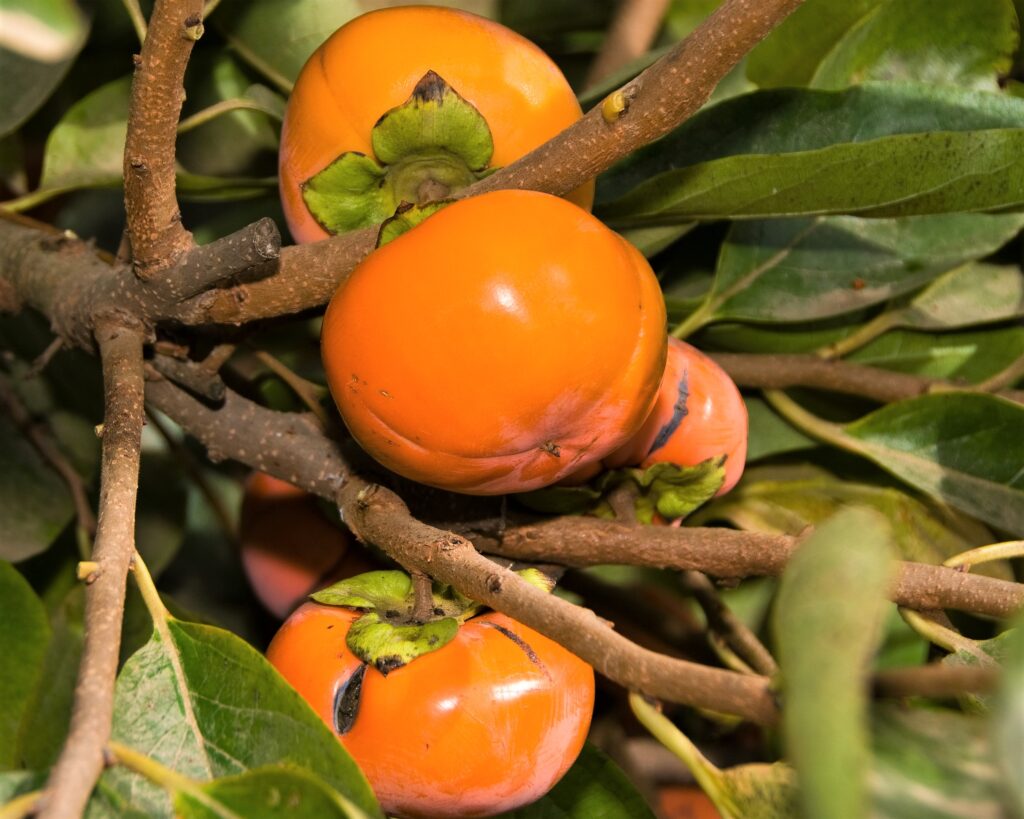
(Diospyros kaki ‘Fuyu’)
Description:
Loosely translated, the scientific name of persimmons means “food of the Gods” and this is one of the most popular cultivars for good reason! Unlike other persimmons that can be astringent unless fully-ripe, the ‘Fuyu’ can be eaten like an apple when still firm or can be allowed to soften as it gets sweeter with a creamier texture. In addition to producing exceptionally large fruits, they are also known for their superior flavor, very sweet with subtle notes of apricot and sugar cane.
Bonus: The vigorous trees are self-fruitful and make beautiful ornamental specimens with showy dark orange fruit and striking fall foliage.
Pro tip: Freeze the fully ripe fruit and set out on the counter for 15 mins to soften. Then cut off the top, grab a spoon, and eat like a kid’s ice cream cup.
Although the fruits are incredible fresh, they can also be dried, made into phenomenal preserves, baked into a traditional persimmon pudding for Thanksgiving or substituted for mangos in salsa with end of season tomatoes and peppers!
ESTIMATED CHILLING REQUIREMENTS (BELOW 45 DEGREES): 200
COLD HARDINESS: Needs protection at or near 0-5° F
POLLINATION: Self-fruitful
RIPENING DATE: November
ROOT STOCK: Native Persimmon adapted to North Texas
SPACING: Plant trees 15 feet apart
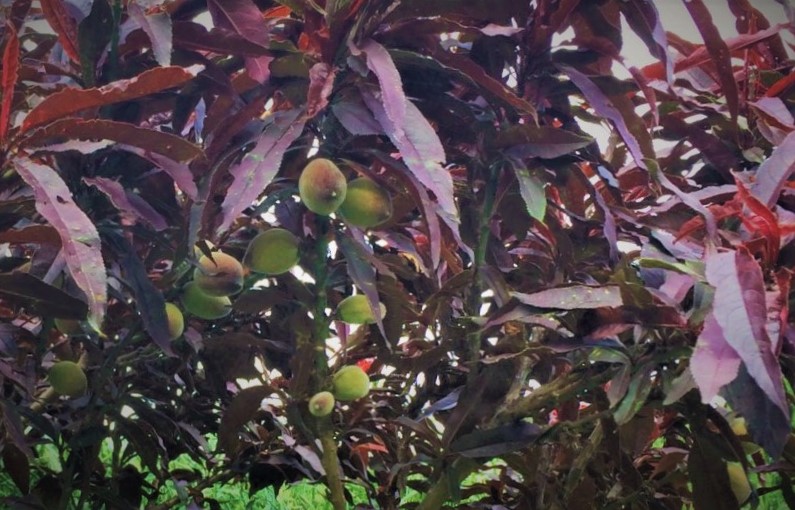
(Prunus persica ‘Bonfire’)
Description:
The ‘Bonfire’ peach is without a doubt the most beautiful peach tree on the market with stunning burgundy-colored leaves and with be covered in spectacular large pink blooms that give rise to sweet succulent peaches that are packed with flavor. Perfect as a specimen in an edible landscape, ‘Bonfire’ is a genetic dwarf and easy to manage for the beginning fruit grower, reaching a mature height of 6’ .
The red-striated, white to yellow fleshed fruits ripen in summer and are perfect for pies and canning or simply eating fresh. If you have limited space in the landscape or need the perfect fruit tree for a container, you can’t go wrong with a ‘Bonfire’ peach!
Bonus: As mentioned, the rich pink flowers of the ‘Bonfire’ are dense and more showy than traditional peach cultivars, with double the petals. The flowers are also edible, slightly sweet but intoxicatingly scented and make an exquisite garnish to salads, desserts and cocktails.
TREE SIZE: 2 Year Old Dwarf Tree
ESTIMATED CHILLING REQUIREMENTS (BELOW 45 DEGREES): 400
COLD HARDINESS: -5° to -10° F
POLLINATION: Self-Fruitful (No Pollinizer Required)
STONE FREENESS: Freestone
RIPENING DATE: Summer
ROOT STOCK: Grow on their own roots
SPACING: Plant trees 8-10 feet apart.
FLAVOR OF FRUIT: Often misidentified as strictly ornamental, when properly thinned and fertilized the smaller fruits are slightly firm and delicious when allowed to fully ripen!
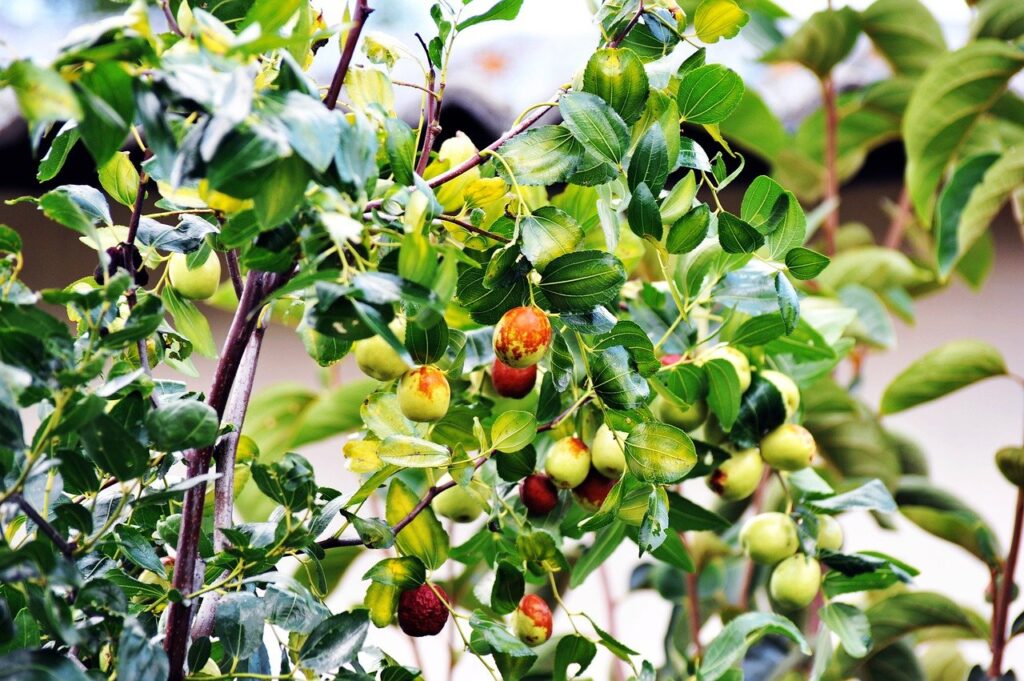
(Ziziphus jujuba ‘Shanxi Li’)
Description:
The best home-grown fruit tree that many gardeners have never heard of! When fresh the 1 ½ ”+ long fruits of this tree are crisp, they taste like the perfect cross between a pear and a green apple. When dried, they transition to dark red and are reminiscent of a sweet date. So much so– that they are also referred to as the “Chinese date”.
‘Li’, is one the best of all the jujube cultivars, providing one of the largest (and some of the best tasting) fruit, on a tree that has to be the easiest fruit tree to grow in the tough Texas climate! They are extremely fast producers and because they bloom later that other fruit trees, you never have to worry about late freezes. And because they’re self-fertile you only need one to produce fruit!
Enjoy their fruits straight from the tree as a refreshing summertime snack, as an exceptional dried fruit, or as the main ingredient in delectable marmalades and preserves. Jujubes are phenomenal!
Bonus: They are also super healthy, often revered as a superfood in Asian cultures thought to reduce stress and inflammation.
TREE SIZE: 2 years old
POLLINATION: Self-Fruitful, but can produce more with other Jujubes nearby
COLD HARDINESS: -5° to -10° F
STONE FREENESS: Small Pit
SIZE AT MATURITY: 12-16 feet when pruned
CHARACTERISTICS OF FRUIT: 2 inch long fruits, sweet apple flavor
*Extremely Drought Tolerant